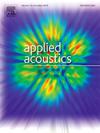A prototype methodology for acoustic heritage preservation: integrating H-BIM and legal frameworks for the protection of intangible cultural assets
IF 3.4
2区 物理与天体物理
Q1 ACOUSTICS
引用次数: 0
Abstract
This study explores a potential approach to documenting the acoustic characteristics of sacred spaces through the integration of acoustic and psychoacoustic analysis and Heritage Building Information Modeling (H-BIM) tested on the S. Flaviano Church. While traditional Building Information Modeling (BIM) typically focuses on contemporary architecture, this research investigates how H-BIM methodologies can be adapted to help document acoustic features that contribute to the experience of historical religious buildings. The proposed methodology attempts to combine psychoacoustic data with objective acoustic measurements to explore ways to capture the acoustic environment of sacred spaces. In this study, acoustic objective measurements and subjective ratings from 41 attendees during a Sunday service were collected. The results revealed significant correlations between the subjective impressions and objective parameters. Specifically, subjective ratings of reverberation aligned moderately with RT30 measurements (r = 0.62, p < 0.01), and speech intelligibility ratings correlated with STI values (r = 0.55, p < 0.01). The overall acoustic quality rating was found to be influenced by both RT30 and STI, with multiple regression analysis indicating that these parameters collectively accounted for approximately 81 % of the variance in acoustic quality ratings. The integration of acoustic data into the H-BIM model represents an initial exploration towards developing documentation practices that not only consider material aspects but also immaterial aspects such as acoustic characteristics. This preliminary study aims to contribute to the ongoing discussion on preserving the various aspects of cultural heritage in sacred spaces. This research is part of the broader national research initiative funded by PRIN 2022 PNRR ‘The Sound in the Digital Era: Spaces, Identity, Rights and Culture (SoundSIRC)’, which recognizes the significance of acoustic heritage preservation in the Italian cultural context.

声学遗产保护原型方法:将 H-BIM 与保护非物质文化资产的法律框架相结合
本研究通过声学和心理声学分析与遗产建筑信息模型(H-BIM)的结合,探索了一种记录神圣空间声学特征的潜在方法。虽然传统的建筑信息模型(BIM)通常侧重于当代建筑,但本研究探讨了如何采用H-BIM方法来帮助记录有助于历史宗教建筑体验的声学特征。所提出的方法试图将心理声学数据与客观声学测量相结合,探索捕捉神圣空间声环境的方法。在这项研究中,收集了41名参加周日礼拜的人的声学客观测量和主观评分。结果显示主观印象与客观参数之间存在显著的相关性。具体而言,混响的主观评分与RT30测量值适度一致(r = 0.62, p <;0.01),语音清晰度等级与STI值相关(r = 0.55, p <;0.01)。整体音质评级被发现受到RT30和STI的影响,多元回归分析表明,这些参数共同占音质评级方差的约81%。将声学数据集成到H-BIM模型中代表了对开发文档实践的初步探索,这些实践不仅考虑了材料方面,还考虑了声学特性等非物质方面。这项初步研究旨在为正在进行的关于在神圣空间中保存文化遗产的各个方面的讨论做出贡献。这项研究是由PRIN 2022 PNRR资助的更广泛的国家研究计划的一部分“数字时代的声音:空间、身份、权利和文化(SoundSIRC)”,该计划认识到声音遗产保护在意大利文化背景下的重要性。
本文章由计算机程序翻译,如有差异,请以英文原文为准。
求助全文
约1分钟内获得全文
求助全文
来源期刊

Applied Acoustics
物理-声学
CiteScore
7.40
自引率
11.80%
发文量
618
审稿时长
7.5 months
期刊介绍:
Since its launch in 1968, Applied Acoustics has been publishing high quality research papers providing state-of-the-art coverage of research findings for engineers and scientists involved in applications of acoustics in the widest sense.
Applied Acoustics looks not only at recent developments in the understanding of acoustics but also at ways of exploiting that understanding. The Journal aims to encourage the exchange of practical experience through publication and in so doing creates a fund of technological information that can be used for solving related problems. The presentation of information in graphical or tabular form is especially encouraged. If a report of a mathematical development is a necessary part of a paper it is important to ensure that it is there only as an integral part of a practical solution to a problem and is supported by data. Applied Acoustics encourages the exchange of practical experience in the following ways: • Complete Papers • Short Technical Notes • Review Articles; and thereby provides a wealth of technological information that can be used to solve related problems.
Manuscripts that address all fields of applications of acoustics ranging from medicine and NDT to the environment and buildings are welcome.
 求助内容:
求助内容: 应助结果提醒方式:
应助结果提醒方式:


